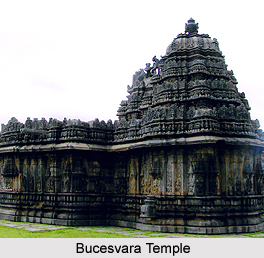 The Bucesvara temple, a specimen glorifying the architectural brilliance of the Hoysala Empire, is located in the village of Korvangla in Hassan district in Karnataka. The village is located at a distance of almost 10 kms from Hassan city. This 12th century edifice that withstood the ambush of the medieval and modern vandalism was constructed by a wealthy officer called Buci in 1173 A.D. to commemorate the coronation ceremony of the Hoysala King Hoysala Ballala III. A monument commanding national significance is presently is maintained by the Archaeological Survey of India.
The Bucesvara temple, a specimen glorifying the architectural brilliance of the Hoysala Empire, is located in the village of Korvangla in Hassan district in Karnataka. The village is located at a distance of almost 10 kms from Hassan city. This 12th century edifice that withstood the ambush of the medieval and modern vandalism was constructed by a wealthy officer called Buci in 1173 A.D. to commemorate the coronation ceremony of the Hoysala King Hoysala Ballala III. A monument commanding national significance is presently is maintained by the Archaeological Survey of India.
Architecture of Bucesvara Temple
The Hoysala rulers, upon succeeding the later Chalukyas, established their empire in Mysore Plateau. Being great lovers of art, they patronised it by erecting several monuments and cultivating new forms and techniques of architectural patterns. The Bucesvara Temple is chiefly a star-shaped edifice and is a divikuta i.e. two shrines by plan. The shrines facing each other are linked by a closed and open mantapa or hall. A small shrine, dedicated to Bhairava, a form of Lord Shiva, is located at the eastern side of the complex. A Sukhanasi defined by a projection of the tower above the shrine links the vimana with the hall.
The other shrine on the western side houses the image of Lord Surya. Facing the east side, the temple is square in plan having three projections. The khalasa, a well designed water-pot preserved on the tower top and a Hoysala sculpture portraying a warrior attacking a lion augment the beauty and appearance of the temple. The embellished sikhara and the exterior walls depict the finest workmanship of the Hoysala artisans.
Equally interesting are the miniature towers on pilasters that exhibit outstanding workmanship in different styles such as vesara, nagara, dravida and bhumija. The eaves protruding almost half a metre encircles the temple. The huge wall images of gods and goddess along with their attendants, caved below the adorned towers, are a treat to the eyes. These figures include Maheshvara, Bhairava, Goddess Durga, Goddess Saraswati, Lord Brahma, Narasimha and Venugopala. Besides, the lower part of the wall has five alternative horizontal mouldings. The temple houses two halls, a closed one and another open. The closed in thoroughly decorated but the open hall is however, incomplete. Above the eaves there is no structure and only offers two side entrances into the temple. The entrance gate on the southern side in decorated with two small elephant balustrades. The exterior wall of the closed hall exhibits some curious iconography of animals devouring animals. The pillars of the mantapa (hall) are bell shaped and have a glossy finish.
The rhetorical development of temple and its elite construction techniques has caught the attention of several tourists, both local and international who frequent the shrine from various destinations.





















